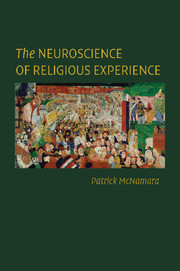Book contents
- Frontmatter
- Contents
- Preface
- Acknowledgments
- 1 God and the Self
- 2 On the Self and the Divided Self
- 3 Mechanisms and Dynamics of Decentering
- 4 Neurology of the Self
- 5 Neurology of Religious Experiences
- 6 Neurochemistry of Religiosity
- 7 Self-Transformation as a Key Function of Performance of Religious Practices
- 8 Self-Transformation through Spirit Possession
- 9 God Concepts
- 10 Religious Language
- 11 Ritual
- 12 Life-Span Development of Religiosity and the Self
- 13 The Evolution of Self and Religion
- References
- Index
6 - Neurochemistry of Religiosity
Published online by Cambridge University Press: 30 October 2009
- Frontmatter
- Contents
- Preface
- Acknowledgments
- 1 God and the Self
- 2 On the Self and the Divided Self
- 3 Mechanisms and Dynamics of Decentering
- 4 Neurology of the Self
- 5 Neurology of Religious Experiences
- 6 Neurochemistry of Religiosity
- 7 Self-Transformation as a Key Function of Performance of Religious Practices
- 8 Self-Transformation through Spirit Possession
- 9 God Concepts
- 10 Religious Language
- 11 Ritual
- 12 Life-Span Development of Religiosity and the Self
- 13 The Evolution of Self and Religion
- References
- Index
Summary
And it shall come to pass afterward, that I will pour out my spirit upon all flesh;
and your sons and your daughters shall prophesy, your old men shall dream dreams, your young men shall see visions.
– Joel Ch. 2Introduction
Once a year, the Huichol Indians of the Southwest United States and northern Mexico make a kind of pilgrimage across hundreds of miles to gather the peyote they use in their religious ceremonies (Schaefer & Furst, 1997). The trek is led by an experienced “mara'akame” or shaman, who is in contact with God-ancestor Tatewari (grandfather-fire). Tatewari, also known as Hikuri, is personified with peyote plants on his hands and feet. Upon arriving within sight of the sacred mountains of Wirikuta, the shaman begins the ritual cleansings and chants that will initiate the dangerous crossing into the Otherworld, facilitated by peyote. The shaman supervises preparation of the hikuri plants as the fresh cacti are grinded into a pulp on a metate, with each drop of liquid oozing from the pulp collected in a gourd. Participants are served the peyote and sing songs that praise peyote for its protection of the tribe. During the many hours of the religious rite while they are intoxicated with peyote, the participants see visions, receive guidance, and experience a religious form of ecstasy that enriches them spiritually and sustains them emotionally as they go about the rest of their lives.
- Type
- Chapter
- Information
- The Neuroscience of Religious Experience , pp. 131 - 144Publisher: Cambridge University PressPrint publication year: 2009



